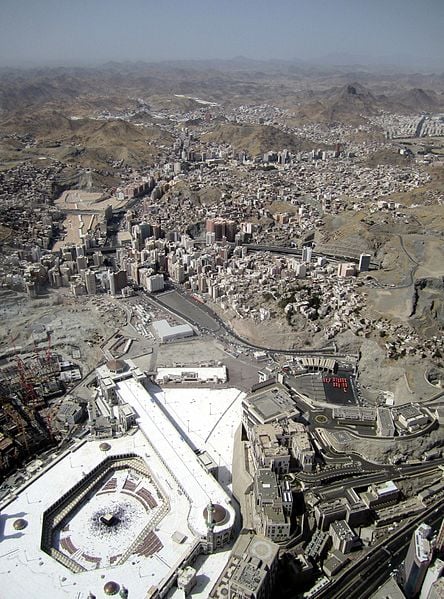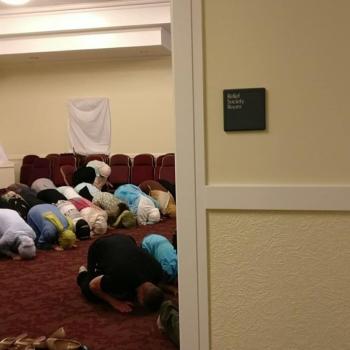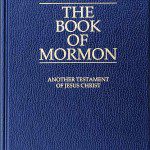
(Wikimedia Commons public domain photograph)
Muhammad in Mecca
Within a few years of his birth at Mecca in 570 A.D., Muhammad, the future prophet of Islam, became an orphan. He had been born into an important clan of the Quraysh, known as the Banu Hashim. (That is why Jordan, whose king claims descent from the Prophet, is even today officially known as “The Hashemite Kingdom of Jordan.”) But, though the Banu Hashim were important, by this point they had also fallen on somewhat hard times. They were like the proverbial penniless aristocrat: they had a rich heritage but no cash. Muhammad clearly could not relax with inherited wealth, so he had to seek some way of making a living. In Mecca, the most promising way to make a living for anyone with ambition and ability—both of which, as later events clearly demonstrate, Muhammad had in abundance—was in caravan trade, and it was into caravan trading that the young man went.
His capacities were apparent to outsiders. Even if we strip away the layers of accumulated legend that attach to his figure, Muhammad emerges from the past as a man of great talent and integrity. By his early 20s, he was managing camel caravans for a rich Meccan widow by the name of Khadija (pronounced “Kha-DEE-ja”). In this role, he made a considerable impression. In fact, she was so impressed with him and his abilities that she soon asked him to marry her. According to tradition, she was forty years old, and he was twenty-five.
It was a happy marriage. While Khadija lived, she was Muhammad’s most loyal supporter and he took no other wife. The marriage gave him freedom from the financial worries that must otherwise have occupied much of the time and attention of a poor young orphan, and he could now direct his focus to the things that really interested him. And what was it that most deeply occupied his interest? Clearly, it was religion. Muhammad should almost certainly be classed among the people we have met as the hanifs. But he was now in exceptionally good circumstances. With money and security, he now had leisure to ponder the weighty issues of life.
When he was about forty—approximately 610 A.D.—mainstream Islamic tradition represents Muhammad as meditating and praying in a cave of a mountain called Hira, located near Mecca. According to tradition, the angel Gabriel appeared to Muhammad and commanded him to read or (the words are identical in Arabic) to recite:
“Recite: In the Name of thy Lord who created, created Man of a blood-clot. Recite: And thy Lord is the Most Generous, who taught by the Pen, taught Man that which he knew not.”[1]
Thus began the revelation of the Qur’an. Sometimes known in English as the “Koran,” this is the holy book of the Islamic religion.[2] It was, in many ways, an answer to the religious yearnings long felt by the hanifs. For those who wondered why no revelation had come to the Arabs, it announced “There has now come to you a Messenger of your own.”[3] It pointedly identified itself as “an Arabic Qur’an.”
Muhammad’s reception of the Qur’an would continue from this time to nearly the day of his death, twenty-two years later. Its messages were orally delivered and memorized; only later were they written down by Muslims.
The form of the Qur’an is rhymed prose, but it is not and must not be confused with poetry. The Fatiha or “Opener,” which is the first sura or chapter of the Qur’an, will suffice to make this clear:
In the name of God, the Merciful, the Compassionate. Praise belongs to God, the Lord of all Being,
the All-merciful, the All-compassionate,
the Master of the Day of Doom.
Thee only we serve; to Thee alone we pray for succour. Guide us in the straight path,
the path of those whom Thou hast blessed,
not of those against whom Thou art wrathful,
nor of those who are astray.
I have told you that this is rhymed prose, but you can only know that if you read Arabic or if you are very trusting. I shall therefore try to help you read it yourself. In my very unscientific transliteration—where, as before, italicized syllables receive the emphasis— this chapter sounds something like the following:[4]
Bismee laah irahmaan iraheem
Al-hamdoo li laahee rabb al-aalameen
Irahmaan iraheem
Maalik eeyom iddeen
Eeyaaka na‘boodoo wa eeyaaka nasta’een
Ihdinaas siraat al-mustakeem
Siraat alatheena an’umta alayhim wa laa daaleen. Ameen.[5]
Several things can be noted about the Arabic original of this chapter, things that are for the most part also true of the other chapters of the Qur’an that were revealed in Mecca. First, each line of the transliteration represents a verse. Thus, it can be seen that the verses are quite short. This is typical of chapters revealed in Mecca; they are always relatively short and made up of short individual verses. But it will also be noted that the verses are of widely varying lengths. The third verse, for instance, contains only six syllables, while the last, even omitting the Ameen, comprises sixteen.[6] Therefore, although the verses of the Qur’an have rhyme, they do not have meter. Thus, strictly speaking, they are not to be considered poetry.
[1] 96:1-5; Arberry. Almost all of the quotations from the Qur’an in this book are taken from the translation of N. J. Dawood. Those taken from that of A. J. Arberry, or from M. M. Pickthall, or translated by myself, will be so marked. Where a reference is given in the footnotes to chapter and verse, but without an identifying book (e.g. “Mosiah,” or “Genesis”), it is to be understood that the reference is to the Qur’an. I have not infrequently made slight modifications to the translations I have used, for clarity and consistency. (Thus, for example, Dawood’s Allah is routinely changed to God, both in order to match Arberry’s usage and to accord with my own preferences.)
[2] Qur’an is the most accepted spelling of the word among modern authorities because it makes clear the derivation of the title from the verb qara’a, meaning “to read” or “to recite.” Thus, Qur’an could be translated approximately as “Reading” or “Recitation.”
[3] Qur’an 1; Arberry. The phrase “In the name of God, the Merciful, the Compassionate,” occurs at the beginning of every chapter of the Qur’an but one. Only the ninth chapter lacks it, for no obvious reason.
[4] I offer my apologies to any Arabist who might be reading these lines. I have made an effort here to transliterate the Arabic in such a way that non-Arabists, who will make up the overwhelming majority of this book’s readers, will have an approximate idea of how to pronounce it. I am aware that the results look a bit silly—especially, perhaps, in this instance. I can only say that they hurt my eyes, too. Incidentally, the th in alatheena is to be pronounced like the th in English that, rather than like the th in thing.
[5] The final Ameen—which is simply Amen, and which often shows up in Arabic and other Muslim proper names, in the meaning of “faithful” or “true,” as Amin—does not actually occur in the text, but is routinely added by reciters at the conclusion of a chapter of the Qur’an. I like to add it here since it matches the rhyme scheme of the chapter. Of course, not all chapters of the Qur’an have this particular rhyme.
[6] .9:128.












